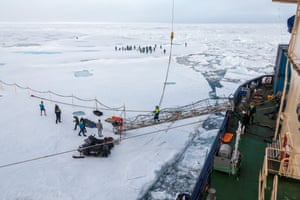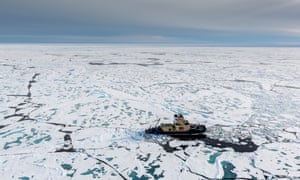Extract from The Guardian
Dozens of scientists, Helen Czerski among them, are at work in the
Arctic, seeking answers to questions that profoundly affect the future
of everyone on the planet
I
am standing on the ocean. Ahead of me, the world is split into two
perfect halves: blue sky above, white sea ice below. The view is clean
and simple, but a continuous waltz of swirling and shunting is hidden
inside those two colours: the inner workings of the Arctic engine.
This place is special for many reasons, and to appreciate one of the most unusual all I need to do is to live; to breathe. The air is -2C, but the air coming from my lungs is invisible. The familiar wisps of cold breath that I associate with crisp winter air in Britain are absent. They cannot form here. And that anomaly is connected in a fundamental way to our presence here, on a scientific expedition to study this environment. For two months, the Swedish icebreaker Oden is home to 74 of us, living and working at the top of the world to tap into the stories that the blue and the white have to tell.
Each floe is mostly flat on top, and right now they’re dotted with curvy, light-blue melt ponds as weak summer sunlight trickles into the ice for 24 hours every day. Dark ocean fills the gaps created as floes move apart, but in some places there is no open water for miles. Above the ice, clouds and fog are the norm, and often the entire world is painted only in shades of white. It is quiet.
Oden is an experienced voyager in these waters. It was the first non-nuclear ship ever to reach the north pole (in 1991), capable of breaking through a continuous ice layer that is two metres thick. Just the existence of this ship is testimony to human determination to explore challenging environments.
But on this trip, the desire to go one step further is merged with self-preservation. The Arctic may be a long way from most of us, but what happens here matters to all of us. The weather up here is intimately connected to the patterns of weather further south, particularly the jet stream that feeds endless British conversations about the weather. As the sea ice melts, shipping routes are opening up across the Arctic, bringing questions about regulation and control over this previously inaccessible region. And this is an important area for many species, providing summer feeding grounds for visitors from the south. The Arctic may be a long way away, but it is woven into all our lives.

This place is special for many reasons, and to appreciate one of the most unusual all I need to do is to live; to breathe. The air is -2C, but the air coming from my lungs is invisible. The familiar wisps of cold breath that I associate with crisp winter air in Britain are absent. They cannot form here. And that anomaly is connected in a fundamental way to our presence here, on a scientific expedition to study this environment. For two months, the Swedish icebreaker Oden is home to 74 of us, living and working at the top of the world to tap into the stories that the blue and the white have to tell.
Each floe is mostly flat on top, and right now they’re dotted with curvy, light-blue melt ponds as weak summer sunlight trickles into the ice for 24 hours every day. Dark ocean fills the gaps created as floes move apart, but in some places there is no open water for miles. Above the ice, clouds and fog are the norm, and often the entire world is painted only in shades of white. It is quiet.
Oden is an experienced voyager in these waters. It was the first non-nuclear ship ever to reach the north pole (in 1991), capable of breaking through a continuous ice layer that is two metres thick. Just the existence of this ship is testimony to human determination to explore challenging environments.
But on this trip, the desire to go one step further is merged with self-preservation. The Arctic may be a long way from most of us, but what happens here matters to all of us. The weather up here is intimately connected to the patterns of weather further south, particularly the jet stream that feeds endless British conversations about the weather. As the sea ice melts, shipping routes are opening up across the Arctic, bringing questions about regulation and control over this previously inaccessible region. And this is an important area for many species, providing summer feeding grounds for visitors from the south. The Arctic may be a long way away, but it is woven into all our lives.

Answers to those questions are essential to improve the weather forecasts for this region, and to allow us to predict the effects of the substantial changes in temperature and sea ice that have been observed.
Sea ice doesn’t just matter for its own sake. It has a strong influence on both the ocean and atmosphere, and the consequences tweak our planet’s energy budget. The solar energy that flows into the Earth system is mostly absorbed in the tropics, transported northwards by the atmosphere and ocean, and eventually re-emitted into space as infra-red radiation.
The Arctic balance sheet controls the final part of that process, and the keys to the energy flow through this vast icy wilderness are held by the clouds. Oden is a tiny speck in the white, drifting with the sea ice only a few miles from the north pole, perfectly positioned between the clouds and the ocean to watch and sample and learn.
The reason I can walk outside on a perfectly clear and very cold day and still not see my breath is that the air here is astonishingly clean. Air carries tiny particles, known as aerosols, which form from gases in the atmosphere, or come from vegetation, dust and sea spray. Human-generated pollution adds more, and the air most of us breathe has tens or hundreds of thousands of aerosol particles in every cubic centimetre. On a crisp morning in Britain, the water vapour I breathe out quickly condenses on to those particles, making tiny liquid droplets that I can see. Here at the north pole, there are fewer aerosol particles than almost anywhere on Earth – fewer than 10 per cubic centimetre.
The atmospheric scientists on board are fantastically excited about sampling such rare conditions and such clean air. Very few measurements have ever been made in these conditions, and the meteorological data from this expedition is especially valuable.
"The ice is fickle, and everyone working on it must be accompanied by a guard against polar bears."
Every cloud droplet needs one of these aerosol particles to get started, and it can be one of two types. There are cloud condensation nuclei, on which water condenses to form liquid droplets, and ice nuclei, which have the perfect surface for ice crystal formation. This is the link to Arctic biology, because tiny organisms in the ocean spit out material with just the right characteristics to do those jobs.
That could be very important, if those molecules are regularly ejected upwards from the ocean. But the ice cover acts as a lid, and the low wind speeds leave the small patches of open water unruffled. There is a mystery here to solve – the air here is so clean because there are very few sources of aerosol, especially the types needed to form clouds. But almost every day is overcast, so there must be enough coming from somewhere.
It’s a complex problem, and so the scientists on board have a variety of specialisms. I’m living with and learning from ice physicists, chemists, atmospheric scientists, biologists and oceanographers. When questions come up over breakfast, the person with the answer or the necessary equipment may well be at the next table. And everything is easy when you ask the right person. A few days ago, I had a problem with slush forming in a hole drilled through the ice, making me worry it would freeze up. One researcher on board took me to his workshop, and made my day by producing a collection of shiny steel kitchen sieves, strainers and scoops that any posh restaurant would be proud of, brought specifically to scoop icy slush out of holes.
The practical challenges loom large in all our lives, and they can’t all be solved with a sieve. We are moored next to a large ice floe around 2km in diameter, drifting with it as it meanders close to the north pole. It is nearly two metres thick almost everywhere, and unusually flat on both the top and the bottom. It’s likely that the floe is around three years old, and originated in Siberia. It provides a surprisingly stable platform to work on, and it’s now home to a 15-metre meteorological mast, two large tethered balloons for lifting sensors into the clouds, a large hole covered by a tent which is the base for a robot submarine, and a small harbour on the far side for launching experiments that float.
We walk out to our work sites after breakfast and return for dinner. It’s the closest to a nine-to-five job I’ve ever had. But the temperature is always zero or below, ice is fickle, and everyone working on it must be accompanied by a guard watching out for polar bears.
My own tiny piece of this picture is out at the harbour, or “open lead”, a place where there’s a watery gap between floes. One of the proposed routes for biological material to get into the clouds is for bubbles in the water to burst and spit minuscule droplets upwards. Bubbles have been seen in these open leads, but we don’t know how they form or how important bubble bursting is for transporting biological material from the ocean into the atmosphere. I’ve got an ocean bubble camera that peers into the water just below the surface, my electronic eye in the watery world below. I’ve also got a collection of other sensors to follow water flow velocities, dissolved gas, temperature and salinity. My colleague Matt Salter has a floating chamber that sits next to the camera like an umbrella over the water surface, collecting particles from below instead of deflecting rain drops from above. Between us, we can monitor both the bubbles and the particles they spit upwards, so we hope to quantify their importance, filling in one tiny gap in humanity’s knowledge of the Arctic.

Understanding this environment is slow work, but the need is urgent. This region is already changing very rapidly, and we cannot understand the importance of a change if we don’t understand the starting point. Expeditions like this are difficult and expensive to run, but the data they produce is essential. In the next couple of weeks, there will be plenty of news stories about the annual sea ice minimum, but less discussion about the specifics of why it might matter. If the ice changes, many other things will also change, and we need to predict the consequences.
As I stand on the ice on this rare clear day, breathing the cleanest air of my life, I wonder what this might be like in 10 or 20 or 50 years’ time. A newly accessible ocean comes with a lot of complications – ships and people and pollution and territorial claims – and maybe air this clean won’t exist on Earth for much longer. Will that matter? We don’t know, though answers from this expedition may help us find out.
But for now, a human can still stand on the ocean at the top of the world, breathe in the freezing air of summertime and breathe out, invisibly.

No comments:
Post a Comment